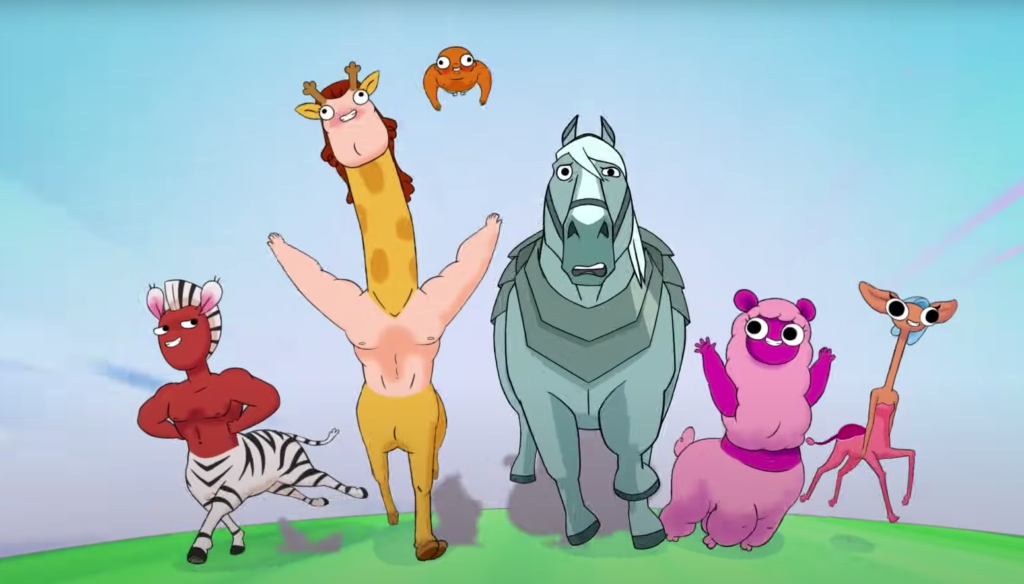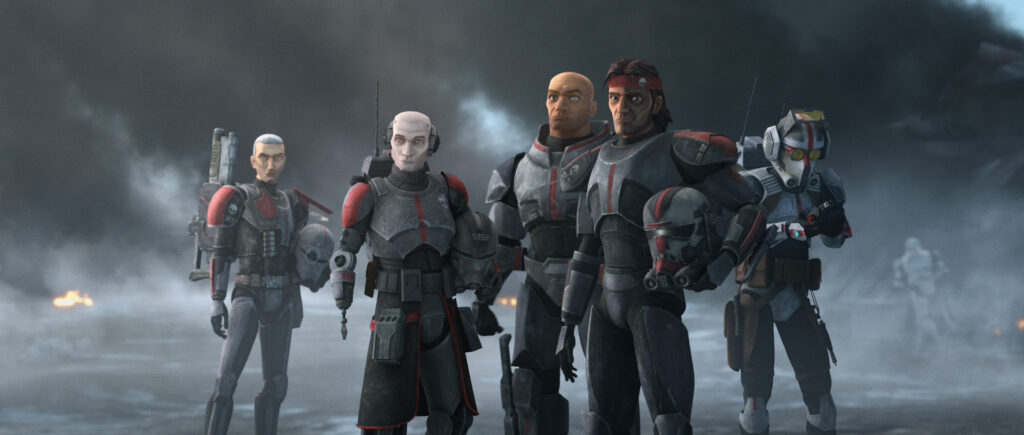
At the very least, Centaurworld is a visually rich piece of animation. In some ways, the fluidity and elastic movements of a lot of the action and expressions are better than the sharp, cinematic quality of Green Eggs and Ham, itself a fine show that probably would have worked as a movie than serialized programming. Centaurworld has a fine handle on its goofier moments, of explicit closeups and elaborate dance moves, in nifty montages and explosions of color and effects that draw the viewer eye and helps to, perhaps, ease audiences more prone to shy away from the specific and weird character designs themselves. Horse and Rider are the traditionally animated figures of the show; the centaurs of Centaurworld are what if the bubble-designs of Steven Universe would look like if forced into a Day-Glo, Laffy-Taffy machine, and it’s remarkable how the animators are able to bridge those stylistic differences so smoothly. Horse, mostly hard, sharp lines, ends up screaming and singing in silly, exaggerated, squash-and-stretch ways, and damn, it somehow works.
The story that’s told across the ten episodes of Centaurworld, however, is pretty undercooked. I started to get a bit hyped for the show when it got a bit of push on social media–a lot of talented animators, writers, and musicians worked on the show, and their words suggested something quite special. The trailers and the publicity photos also suggested something layered (if not quite new): similar to AdventureTime, the candy-coated universe of Centaurworld was something of a cover, or a mask, or a distraction, to the secondary, bookended “real” world where war thrived and lives were lost.
It’s not that. Well, not exactly. Honestly, I can’t quite put my finger on what Centaurworld is, exactly, both in the narrative/settings sense and in the broader, “what is this show even about” sense. It’s a fine show, but I found it somewhat messy and fairly… incomplete. Similar to The Owl House and Star Vs. and Amphibia and The Dragon Prince, shows with huge worlds and stringent lore and copious amounts of backstory, it all yet feels like a lot of the actual plot is being made up on the fly. There’s only two significant story reveals that occur during the course of the season, and while there are smaller flashes of dramatic narrative that pop up, they happen awkwardly and haphazardly. Centaurworld is too caught up in its “all-encompassing-ness”–in its absurd characters, its padded joke-telling, its weirdness. It has tons of confidence in its characters as entertaining weirdos being weird at each other, but they’re not exactly deep, so the premise is based whether you get a kick out of their antics. Comedy is subjective, so maybe there’s a ton of people who love these oddballs, but as avatars guiding us through this whole new world, they’re lackluster.
Kipo and the Age of Wonderbeats understood it had to clarify its new world first and foremost, to establish the rules, the boundaries, the obstacles that define it. Centaurwold doesn’t. It starts to, but then, I believe, assuming it could do the bulk of that next season, kind of just fucks around. It’s non-Horse cast contorts in weird ways and say very oddball things in very oddball ways, and they trail off or stammer around awkward moments, and they provide creepy expressions as the camera linger on them in extreme close-ups. They can “shoot miniature versions of themselves out of their hooves,” miniature versions who scream and panic because they suddenly exist and can’t handle it, a well that Rick & Morty has all but tapped dry. Centaurwold has the vibe of a Youtube poop mixed with those streaming videos cut so erratically that you can’t quite tell what the joke is, all while forgetting to clarify or develop the characters through that chaos. Horse and Ched bicker a lot, but for the life of me I couldn’t understand why they hated each other; their argument pops up in one episode randomly because, I guess, it sounded funny when they bicker? Durpleton, at one point, gains the ability to fart-verbalize validating compliments, implying that he’s never received that from his father, but the show never unpacks that (they even joke about not unpacking that) and it’s prolonged for so long with no real payoff.
There’s an episode where the characters find themselves in a world that’s a parody of Cats, in which the Cat-taurs compete to win a special sash (which also has a McGuffin they need). Zulius, the showy, stereotypically flamboyant of the group, has history with this competition (he constantly loses it), falling into exaggerated, depressed tantrums before attempting to coach Horse through it. This is pushed as important, revealing backstory (again, they make a meta joke about this) but it never answers the most obvious question: how and why did Zulius, who’s not a Cat-taur, even get so caught up in this very clearly cat-taur-only competition? The episode doesn’t say, and to be honest, it probably could get away with these non-deep deep reveals if the very second episode didn’t provide an extremely, genuinely fraught history with Wammawink. That narrative set up expectations for more fraught or informative reveals in future episodes, but none of them occur.
Centaurworld is ultimately a Weird Cartoon masking as a layered, Steven Universe/AdventureTime one, with the violent backstories, mythical architecture, mysterious characters, and unique iconography never truly being explored. (There’s an implication that the Nowhere King, the show’s Big Bad, and the nameless purple-haired human had a similar bond like Rider and Horse, a bond that in some way caused much of the chaos happening now, but in no way is that explained). The extremely dark narrative of a whale shaman ending the existence of travelers deep in depression is ruined by an obvious sign that literally explains this that somehow everyone missed. It’s the kind of bit that in a lot of ways sums up Centaurworld. Here’s hoping there’s richer, deeper rewards in the second season.

The Bad Batch, on the other hand, probably would have worked better with a lean ten or twelve episodes. It’s an excellent exploration of the aftermath of Order 66, the trigger that called forth the clones to kill all the Jedi in their vicinity. It’s a fascinating, overlooked part of the Star Wars saga, and it’s great to have a in-depth, close look at that transition from Republic to Empire. It does this by focusing on the Bad Batch, a group of clones immune to Order 66 (kind of) and action-heavy stars of average-at-best arc on The Clone Wars.
It was, at the time, odd to see the follow-up to The Clone Wars focus on this team of semi-superpowered clones. (Really, it’s the follow-up to Star Wars Resistance, a show so bad that it’s likely we’ll never see cameos from any of that show’s cast pop up elsewhere.) The Bad Batch, too, is an animated, visual tour-de-force; if the hard-edged, plasticky character models aren’t in the frame, you would swear you were watching live-action. Trees and mountains look lush and full; water effects and weather patterns are massive and dynamic, and explosions and debris damn near burst from the screen. The Bad Batch even ups its visuals by playing around with film trickery, with flashes of focus shifts and whip-pans. The score, too, is rich, bold, and loud: even without surround sound or a subwoofer, you can feel the throbbing bass in your living room or within your headphones.
But again, sixteen episodes is a lot, and like Dave Filoni’s other animated shows, it often struggles to pad out enough material to fill it. Newbie clone (of sorts) Omega, her with the sharp Kiwi accent and the precocious energy, isn’t as much as a distraction as one might suspect: she’s sharp on her toes and rather resourceful, but not so much so that she can escape every scrape that absolutely would require a trained soldier. The Bad Batch mostly struggles through prolonged filler episodes of bounty hunting for Cid (long after they financially escaped her leash) and Filoni’s overwrought penchant to bring in cameos galore (Hera, Saw, Cad Bane, [lady from Mandalorian]. None of the episodes are in any way bad, but seeing this group of mercenary soldiers talk around the same points over and over gets a bit tedious. Dee Bradley Baker voicing five different clones so distinctly and credibly is some kind of miracle; only if the writers could push those characters individually on paper a little harder, The Bad Batch could spend more time developing them specifically instead of broad, stylistic, skill-based ways. What makes them really tick? I hope we get that sooner instead of, like, the six or so episodes before the show’s series finale, like Star Wars Rebels.
Next week I might spill a few words about the silly, rip-roaring The Fast and The Furious: Spy Racers, and allow me to gush about why, finally, they finally figured out Looney Tunes. If I have time/space, I may also shed a few words about some past past animated shows I’ve caught: Hilda, perhaps?
Comments are closed